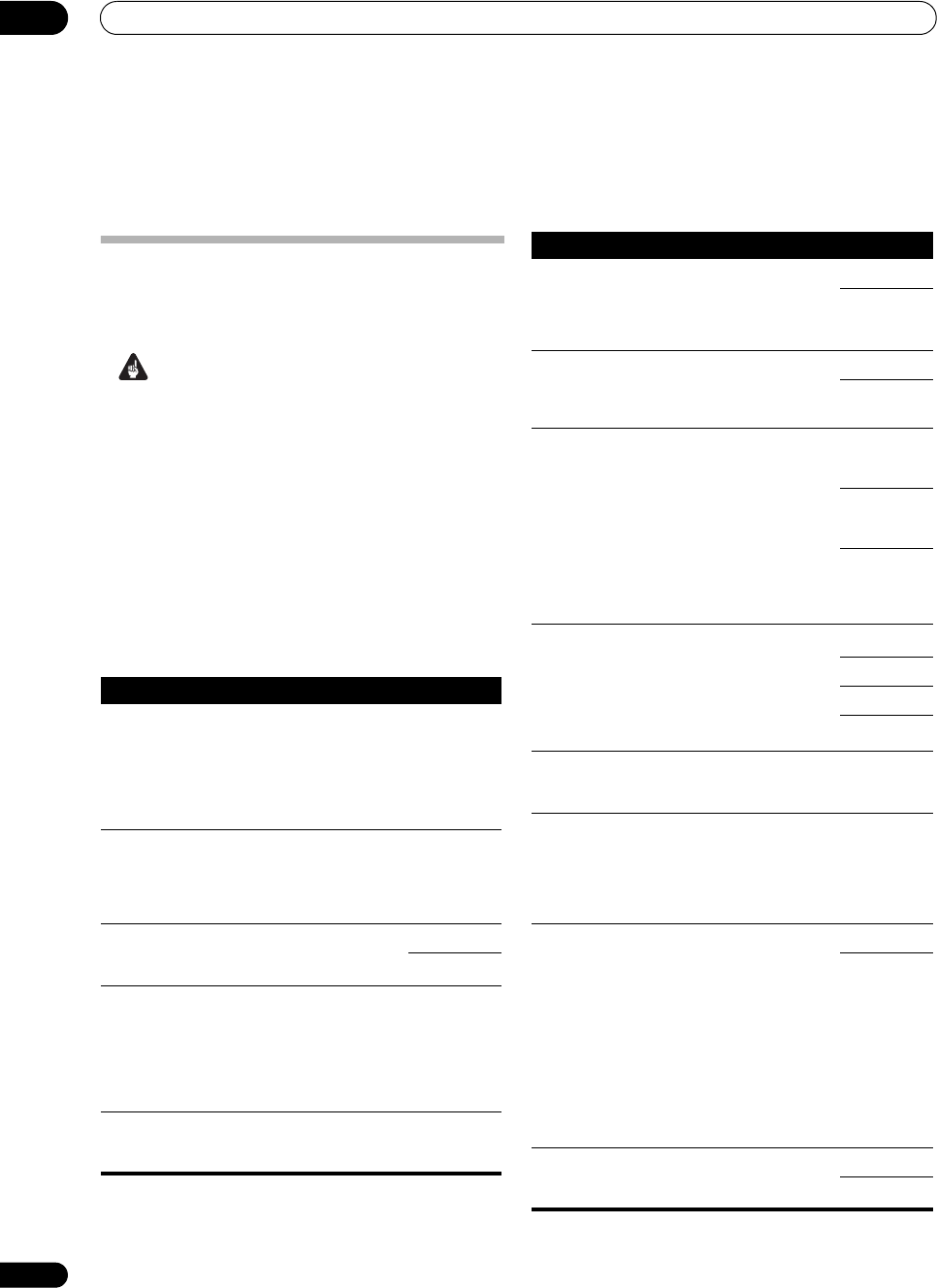
Using other functions
11
58
En
Chapter 11:
Using other functions
Setting the AV options
There are a number of additional sound and picture
settings you can make using the AV Parameter menu.
The defaults, if not stated, are listed in bold.
Important
• Note that if a setting doesn’t appear in the AV
Parameter menu, it is unavailable due to the current
source, settings and status of the receiver.
1 Press
RECEIVER
then press
AV PARAMETER
.
2Use
/
to select the setting you want to adjust.
Depending on the current status / mode of the receiver,
certain options may not be able to be selected. Check the
table below for notes on this.
3Use
/
to set it as necessary.
See the table below for the options available for each
setting.
4 Press
RETURN
to confirm and exit the menu.
Setting What it does Option(s)
C. WIDTH
a
(Center
Width)
(Applicable
only when
using a center
speaker)
Provides a better blend of the front
speakers by spreading the center
channel between the front right and
left speakers, making it sound wider
(higher settings) or narrower (lower
settings).
0 to 7
Default: 3
DIMEN-
SION
a
Adjusts the depth of the surround
sound balance from front to back,
making the sound more distant
(minus settings), or more forward
(positive settings).
–3 to +3
Default: 0
PANORA-
MA
a
Extends the front stereo image to
include the surround speakers for a
‘wraparound’ effect.
OFF
ON
C. IMAGE
b
(Center
Image)
(Applicable
only when
using a center
speaker)
Adjusts the center image to create a
wider stereo effect with vocals.
Adjust the effect from 0 (all center
channel sent to front right and left
speakers) to 10 (center channel sent
to the center speaker only).
0 to 10
Default: 3
EFFECT Sets the effect level for the currently
selected Advanced Surround mode
(each mode can be set separately).
10 to 90
HI-BIT / HI-
SAMP
(High Bit /
High
Sampling)
Creates a wider dynamic range with
digital sources like CDs or DVDs.
OFF
ON
DNR
(Digital Noise
Reduction)
May improve the quality of sound in a
noisy source (for example, cassette
or video tape with lots of background
noise) when switched on.
OFF
ON
DUAL
(Dual Mono)
Specifies how dual mono encoded
Dolby Digital soundtracks should be
played. Dual mono is not widely used,
but is sometimes necessary when
two languages need to be sent to
separate channels.
CH1 – Chan-
nel 1 is heard
only
CH2 – Chan-
nel 2 is heard
only
CH1 CH2
–
Both channels
heard from
front speakers
DRC
(Dynamic
Range
Control)
Adjusts the level of dynamic range for
movie soundtracks optimized for
Dolby Digital, DTS, Dolby Digital
Plus, Dolby TrueHD, DTS-HD and
DTS-HD Master Audio (you may need
to use this feature when listening to
surround sound at low volumes).
AUTO
c
OFF
MAX
MID
SACD
GAIN
d
Brings out detail in SACDs by
maximizing the dynamic range
(during digital processing).
0 to 6 (dB)
Default: 0 (dB)
DELAY
(Sound
Delay)
Some monitors have a slight delay
when showing video, so the
soundtrack will be slightly out of sync
with the picture. By adding a bit of
delay, you can adjust the sound to
match the presentation of the video.
0.0 to 6.0
(frames)
1 second = 25
frames (PAL)
LFE
(LFE
Attenuate)
Some Dolby Digital and DTS audio
sources include ultra-low bass tones.
Set the LFE attenuator as necessary
to prevent the ultra-low bass tones
from distorting the sound from the
speakers.
The LFE is not limited when set to
0 dB, which is the recommended
value. When set to –5 dB, –10 dB,
–15 dB or –20 dB, the LFE is limited by
the respective degree. When OFF is
selected, no sound is output from the
LFE channel.
0dB
–5dB/ –10dB/
–15dB/ –20dB/
OFF
HDMI Specifies the routing of the HDMI
audio signal out of this receiver (amp)
or through to a TV or plasma display.
AMP
THROUGH
Setting What it does Option(s)
VSX-LX50_HY.book Page 58 Thursday, March 8, 2007 1:18 PM


















